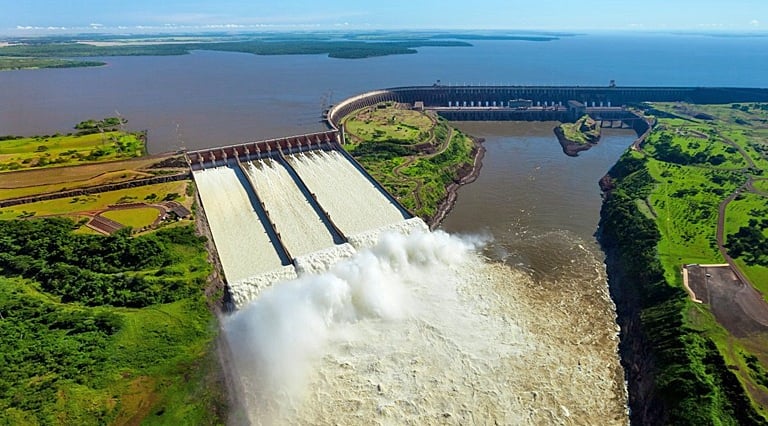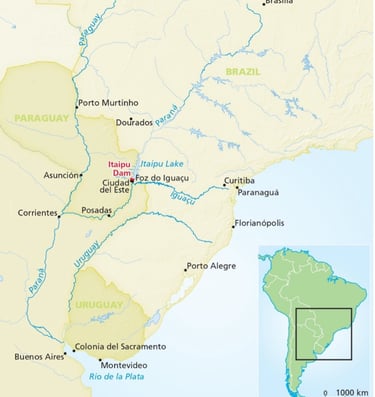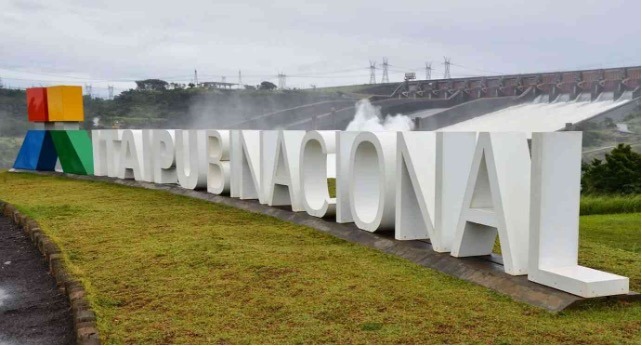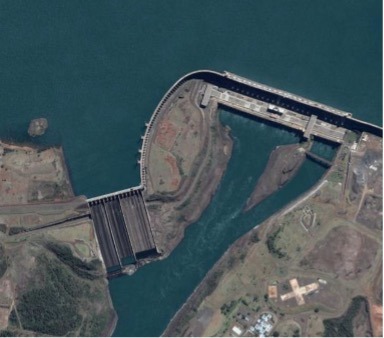

Itaipu Binacional: The Constructive Effect of Water Diplomacy
Jacopo Belli - June 25, 2025
* The cover image of this paper was taken from the Visit Paraguay website, available at the following link: https://www.visitparaguay.net/articles/itaipu-dam.html
Introduction
In an era where water scarcity is increasingly intertwined with geopolitical tensions, water diplomacy emerges as one of the most crucial forms of international cooperation. It refers to the ability of states to negotiate, share, and manage transboundary water resources peacefully and sustainably, not only in practical terms but also as a dynamic tool of foreign policy, aimed at the shared management of resources vital to both humanity and the environment.
Transboundary waters are of global importance. Approximately 313 rivers and lakes and 468 aquifers are shared by two or more countries, and a total of 153 UN member states depend on waters that flow from or to another country. Transboundary rivers alone account for 60% of the world’s freshwater flow, and their basins are home to over three billion people.[1] Building water diplomacy is thus not only a key factor in fruitful international cooperation but also essential for the security of states, which, by sharing water resources, must confront a core national security issue: water security.
Water security is the capacity of a population to safeguard sustainable access to adequate quantities and acceptable quality of water to sustain livelihoods, human well-being, and socioeconomic development; ensure protection against waterborne pollution and disasters; and preserve ecosystems in a climate of peace and political stability.[2]
The Itaipu Hydroelectric Plant
The potential for cooperation between states based on water-related diplomatic relations enables mutual trust over a vital resource, whose uses can evolve into multiple applications.
The Itaipu Hydroelectric Plant is a key example of water diplomacy, embodying new conceptual dimensions of inter-state collaboration by integrating core elements of statehood, such as sovereignty, territory, and independence, into the structure of cooperation.
The plant’s origins date back to the 1960s, when Brazil and Paraguay jointly began exploring the energy potential of the Paranà River. The first step came with the “Iguaçu Act” (“Acta de Iguaçu”) signed on July 22, 1966, by Foreign Ministers Juracy Magalhães (Brazil) and Raùl Sapena Pastor (Paraguay), aiming to study the feasibility of a hydroelectric project to fully harness the shared Paraná waters up to the Iguaçu Falls.[3]
Both countries had shown interest in individually developing the water resources of their border stretch along the Paraná River. True cooperation only materialized after intense diplomatic efforts and negotiations throughout 1969 and 1970. On April 26, 1973, the two governments signed the “Treaty of Itaipu” in Brasília, which came into force on August 13 of the same year. The treaty outlined the principles of binational management, called for an equal split of generation capacity, and established that Paraguay must sell its surplus energy to Brazil until 2023.[4] In the early phases, Buenos Aires raised objections, fearing the project might hinder Argentina’s plans for the Paraná basin. These disputes led to a trilateral agreement signed on October 19,1979 (Itaipu-Corpus Tripartite Agreement) which defined maximum and minimum water flow levels, resolved the dispute, and laid the foundation for broader regional integration.[5]
Nonetheless, Argentina never formally joined the ownership or management of Itaipu and thus remained excluded from the dam’s direct governance, although it was involved in decisions about water levels and cross-border impacts.
To understand the depth of cooperation and the importance of the infrastructure, consider that since 1984 the Itaipu hydroelectric plant has generated over 2.9 billion MWh, ranking among the world’s top hydroelectric producers (as of 2022)[6]. Notably, in 2023, there was a production increase of around 35% in the first half od the year. From January to June 2023, the plant generated a total of 40,651,877 MWh, surpassing the 30,111,313 MWh produced in the same period in 2022.
To put this in perspective, the energy produced in the first six months alone was enough to cover approximately 2.9 times the annual energy demand of all Paraguay.[7]
In 2022, Itaipu supplied about 8.6% of Brazil’s energy needs and 86.3% of Paraguay’s. About 40,000 workers from both countries participated in the project, using enough iron and steel to build around 380 Eiffel Towers. The dam holds a reservoir of roughly 1,350 km², larger than the urban area of São Paulo. Moreover, the area surrounding the dam was the site of the world’s largest reforestation effort with native trees in the buffer zone. An ongoing program for the protection of native flora and fauna is in place, with many species now finding a safe, supportive habitat for survival and repopulation.[8]
Itaipu Binacional
The significant importance of this complex diplomatic operation lies in the fact that it not only involved a massive technical undertaking but also introduced a unique and virtuous theoretical consequence in the management of water diplomacy. Specifically, it introduced one of the most innovative concepts in inter-country collaboration: the concept of binationality.
The dam sits directly on the border, with the left side on the Brazilian city of Foz de Iguaçu and the right side on the Paraguayan city of Hernandarias. In effect, the land, water reserve, and associated infrastructure—such as service roads, monitoring stations, and inspection facilities—are subject to shared sovereignty. Neither state can unilaterally exercise police, taxation, or environmental management functions in the area without consulting and obtaining the other state’s consent.
Itaipu Binacional is legally an international law entity created by the 1973 treaty. Its governance structure includes two administrative councils (one per country), with members appointed by the respective presidents; a Supervisory Council composed of twelve members (six from each country) and a representative from each country's foreign ministry. Strategic decisions require the approval of both “Altas Partes Contratantes,” thus ensuring equal power over financial, technical, and planning matters.
From the perspective of international law, Itaipu is exceptional in that it limits the traditional ius imperii of the two states. Both have partially relinquished sovereignty over a natural and infrastructural asset of strategic importance. Some legal scholars regard this structure as an advanced example of "functional multilateral sovereignty," where cooperation transcends state autonomy in favor of energy efficiency and geopolitical stability. In practice, it translates into a platform for ongoing negotiations, revision of treaty clauses, and conflict resolution via a Conciliation and Arbitration Committee.[9]
International relations always involve a dual dimension, where diplomacy and intelligence are two sides of the same coin, needing to balance cooperation with strategic protection of national interests. In 2025, trust in the infrastructure was severely tested by a crisis on April 1, when Paraguay recalled its ambassador from Brazil and suspended negotiations on Itaipu. This came after revelations that, in 2022, Brazilian intelligence agents had spied on Paraguayan officials regarding tariff negotiations over the dam. The espionage, which occurred between 2019 and 2022 during the Bolsonaro administration, aimed to gather information on Paraguay’s production costs and energy sales strategies. The scandal led to the temporary suspension of talks, revealing the fragility of mutual trust in shared management and highlighting the need for more stringent transparency and oversight mechanisms.[10] Following the scandal, negotiations entered a delicate phase, with both countries seeking mutual clarification, while diplomacy is once again called upon to play a crucial role.
A Model Beyond Borders
The Itaipu experience demonstrates that water diplomacy can serve as a The Itaipu experience demonstrates that water diplomacy can serve as a concrete lever for multilevel development, capable of integrating economic, environmental, and geopolitical interests. In addition to generating over 13 billion dollars in royalties and playing a key role in meeting the energy needs of both Brazil and Paraguay, the dam has fostered social development in border areas, spurred tourism, and supported an economy linked to the plant itself. It has also promoted the preservation of forest corridors, which today represent a shared ecological heritage.[11][12]
The binational model stands out for its ability to adapt over time, with mechanisms for strategic review and dispute resolution that keep cooperation alive. Its management protocol has expanded the use of water resources to new functions such as ecotourism, fishing, and smart irrigation, promoting an integrated approach to territorial development.
It is no surprise, then, that Itaipu’s legal and institutional framework is often cited as a reference by the United Nations and global organizations such as the Global Water Partnership for the sustainable management of other transboundary basins, from the Nile to the Mekong.[13] The lesson emerging from the Itaipu binational experience is ambitious: it stands as a platform of geopolitical innovation, where water diplomacy becomes a driver of cooperation, capable of countering the traditional realist logic of geopolitics. Here, the sharing of a vital resource becomes an opportunity for dialogue and trust between nations and peoples. A truly replicable model (with several existing examples), provided it is based on transparency, balance, and a shared, long-term vision.
_________________________________________________________________________________________________________________________________________________________
[1] UN-Water(2024, Ottobre 1): Progress on Transboundary Water Cooperation. [https://www.unwater.org/publications/progress-transboundary-water-cooperation-2024-update]
[2] UN-Water (2022, Settembre 8). Water Security and the Global Water Agenda. [https://www.unwater.org/publications/water-security-and-global-water-agenda]
[3] Acta de Iguaçu (1966, Giugno 22). [https://www.itaipu.gov.br/sites/default/files/af_df/ataiguacu.pdf]
[4] Tratado de Itaipu (1973, Aprile 24) [https://www.itaipu.gov.br/sites/default/files/u13/tratadoitaipu.pdf]
[5] Barthelmess, E. (2016) As relações Brasil-Argentina no aniversário da Declaração do Iguaçu., Cadernos de Politica Exterior, v. 3m p. 27-43.
[6] Kondlatsch, R. (2023, Gennaio 12). Itaipu reaches 2.9 billion MWh generated since 1984. ITAIPU BINACIONAL | Integration that generates energy and development. [https://itaipu.energy/news/itaipu-reaches-2-9-billion-mwh-generated-since-1984]
[7] Mann, R. (2023, Luglio 7). Itaipu hydropower plant achieves highest production in five years in the first half of the year - The Rio Times. The Rio Times. https://www.riotimesonline.com/brazil-news/brazil/business-brazil/itaipu-hydropower-plant-achieves-highest-production-in-five-years-in-the-first-half-of-the-year]
[8] Turismo Itaipu. (2024, Agosto 6). Curiosidades - Turismo Itaipu. [https://turismoitaipu.com.br/a-usina-itaipu/curiosidades/]
[9] Tratado entre la Republica del Paraguay y la Republica Federativa del Brasil para el aprovechamiento hidroeletrico de los recursos hidraulicos del Rio Parana, pertenecientes en condominio a los dos paises, desde e inclusive el salto del guaira o salto grande de sete quedas hasta la boca del rio Yguazu. [https://www.itaipu.gov.br/sites/default/files/af_df/TRATADOlb.pdf]
[10] Savarese M. (2025, Aprile 1) Brazil’s government admits to spying on Paraguay during Bolsonaro’s presidency, AP news.
[11] Itaipu Binacional (2023) Royalties. [https://www.itaipu.gov.br/en/energy/royalties]
[12] Itaipu Binacional (2023) Environment: Forest and Biodiversity Conservation. [https://www.itaipu.gov.br/en/environment/forest-and-biodiversity-conservation]
[13] Global Water Partnership (2020) Transboundary Water Cooperation and Nexus Governance. [https://www.gwp.org/en/GWP-South-America/]


Figure 1. Geolocation of the Itaipu Hydroelectric Power Plant.https://www.berghahnjournals.com/view/journals/regions-and-cohesion/13/3/images/inline-reco130302_g001.jpg


Figure 2. Sign and logo of Itaipu Binacional.https://cdn.shortpixel.ai/spai/q_lossless+w_500+to_webp+ret_img/nomadicniko.com/wp-content/uploads/2014/06/4466c-dsc_4062.jpg


Figure 3. Top view of the Itaipu Hydroelectric Power Plant.
https://nautica.com.br/vem-ai-o-foz-internacional-boat-show-em-novembro-no-lago-de-itaipu/
Abaqua
Via Cassia, 615
00189 Roma (RM)
© 2024. All rights reserved.
Codice Fiscale: 96584590580


